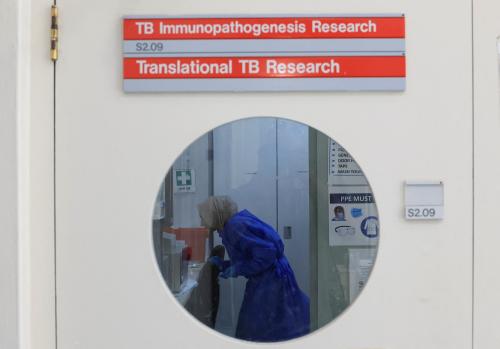Introduction
In addition to a growing appreciation of the role of “social determinants of health”—housing, transportation, nutrition, and other factors in influencing health—it is becoming better understood that certain cross-sector partnerships can be particularly impactful in addressing social determinants and improving health. One of the most untapped of such beneficial partnerships is between the health and housing sectors. The housing and health sectors are natural partners to tackle a range of issues, including ending homelessness, helping older adults age in place, and improving health in under-resourced communities.
Partnerships don’t just happen, however. They need “connective tissue”—an infrastructure supporting frequent and systemic level collaborations—to help form the partnership and hold it together over time. Challenges such as COVID-19, homelessness and housing instability, and even climate change will require cross-sector solutions. Despite progress, the health and housing sectors remain at the elementary stages of developing the connective tissue that can facilitate such collaboration. As we learn more about the nature of this connective tissue, it is clear that concrete steps at the federal, state, and local levels are needed to encourage these sectors to work together to improve equity and effectiveness.
What is connective tissue?
Connective tissue is a way of describing the infrastructure needed to support intentional alignment, coordination, and integration between sectors or organizations that serve the same or similar populations in a community. By “infrastructure” we mean both tangible elements, such as information exchange systems, financing, personnel, shared language, and the intangible elements of trust and shared goals. Developing systems and trust that address cross-sector needs does not just happen; it requires a deliberate process that moves beyond the individual goals of any one system towards a community-wide approach.
Connective tissue typically emerges gradually. Two sectors may start by sharing data to determine overlap between populations, interventions, goals, and methods. At a more evolved stage, staff from each sector may start to work in tandem and identify collaborative roles. Such liaisons encourage long-term relationships and working partnerships to bring the systems together. Sectors need to collaborate to determine the priorities and prioritization processes of their potential partners. Part of connective tissue can be procedures for a cross-sector dialogue to develop joint policy goals; this dialogue can lead to cross-sector referral strategies, for instance, that facilitate coordination at the system level rather than requiring individuals and their families to navigate multiple agencies and organizations on their own. Connective tissue also provides a process for blending and braiding funds from multiple sources to achieve a common objective. And a core feature of connective tissue is to facilitate joint data systems that enable cross-sector data sharing, analytics, and reporting to help drive community-wide policy collaboration.
Why housing-health partnerships are important
Affordable housing can be the platform for the range of services needed to promote good health, with housing as a foundational social driver of health. Using housing as the base for interacting with families, these housing-health partnerships can be particularly valuable for addressing the needs of certain populations, such as older adults and under-resourced families.
Cross-sector collaboration between housing and health can be a means of achieving many important policy goals, such as:
- Successful aging in the home and community.
- Meeting the public health challenge of COVID-19 and the next virus/pandemic, particularly in low-income communities and with large multi-generational households.
- Ending homelessness and housing instability.
- Fulfilling the goal of Olmstead decision, which requires services for community members with disabilities.
- Addressing some of the impacts of climate change.
Health and housing partnerships have a growing track record of success, including:
- Asthma prevention programs that help the housing industry improve the quality of their housing units and health outcomes for residents suffering from asthma.
- Programs that address social isolation and other health issues in older adults.
- Supportive housing models which integrate health care and social services coordination in a placed-based setting to improve health and social success.
- Affordable housing development that is integrated with health centers or Programs of All-Inclusive Care for the Elderly (PACE) that serve older adults or people with complex health care needs.
Successful partnerships like these, however, take intention, time, and resources. As health and housing sector collaboration has evolved over the last decade, each sector has learned of the need for connective tissue to build and sustain long-term, cross-sector collaboration grounded in community priorities and a commitment to building equity.
The components of success
Successful partnerships like these, however, take intention, time, and resources.
The connective tissue for successful partnerships must be built with intentional focus, resources, and concrete goals and objectives. The keys to success include:
- Clearly defined goals that align priorities between sectors and include both the short- and long-term objectives of the collaboration. Short-term goals might include building a health center in an affordable housing development or assessing prevalence of homelessness among those experiencing mental health challenges. A longer-term goal might be to establish system-level connections such as a cross-sector referral system that each sector’s constituents can easily understand and access. A good example of aligning goals is the Portland Oregon FUSE initiative, which coordinates planning between the health, criminal justice, and homelessness sectors.
- Engagement and network development between sectors. Partners working together will create significant scale and work effectively together to change their systems most commonly when they have long-standing trust and an experience in collaboration. Leaders and managers between sectors are often unaware of others’ roles, priorities, challenges, and opportunities. Building cross-sector networks in local communities takes time and educational and trust-building opportunities. Medicaid’s Innovator Accelerator Program (IAP), for instance, was a three-year program designed to provide technical assistance and other support for Medicaid-housing agency partnerships.
- Activities that build networks between sectors. These are concrete projects, such as developing a joint vision and goals between sectors; educating each sector about the other at the system, program, and individual level; and data sharing and pilot program development. Over time these activities can lead to scale and systems change via cross-sector referral networks and joint community reporting.
- Embedded intermediaries often play a critical role in cementing cross-sector partnerships involving health. From data specialists and finance experts to community health workers and building designers, intermediaries with key skills can smooth and improve the partnering process. The most effective intermediaries have expertise and networks in both sectors and fulfill a translator role at the start of the partnership. Communities may use intermediaries to develop a “collective impact” approach that brings together sector partners to achieve change in a community. For instance, in the Denver Social Impact Bond Initiative, launched in 2016, eight private investors partnered with the City and County of Denver to finance supportive housing for 250 individuals who had experienced long-term homelessness and had been frequently involved with the criminal justice system.
- Shared data systems to enable data sharing between individuals and at the aggregate partnership-wide level to drive goals, foster collaboration, and achieve impact measurement. Partnerships evolving successfully over time have built shared data infrastructure to support analytic processes designed with cutting-edge tools. An example is New Jersey linking the Medicaid Management Information System (MMIS), developed by the federal government and states, with the state’s Homelessness Management Information System (HMIS) data to coordinate permanent supportive housing and help reduce health costs.
- Budgeting transparency and coordination. Partnerships are often weakened by the “wrong pockets” problem. This exists when one sector needs to invest in a way that benefits another sector but offers little or no direct cost savings to the first sector. In a housing-health partnership, for example, a housing authority might be considering improving safety features in all bathrooms for older residents. But the main cost saving would be to the Medicare program, not to the housing budget. To help avoid budget managers resisting such investments, it is important to break down budget silos between the partners (who may be local government agencies) so that the broader financial benefits become transparent and built into the budget process. Successful partnerships also require various techniques of braiding and blending funds from different agencies and other sources to combine funds for partnership initiatives. A Maryland Medicaid 1115 waiver, for instance, looks to counties and providers for a cost based rate development for the Assistance in Community Integration Services or ACIS pilots.
Importance of a cross-sector planning team approach to building connective tissue
A cross-sector planning team approach to partnerships is the foundation of “connective tissue.” A successful partnership depends on that team having good knowledge (often with the help of intermediaries) of each sector. The team defines, develops, and leads partnership initiatives. Cross-sector planning teams need to take a multi-pronged approach, typically working with political leaders as well as key individuals in each sector. Successful teams usually need representation from philanthropic organizations, Persons with Lived Expertise (PLE), and community-based organizations.
These discussions may lead to more specific initiatives featuring the components mentioned above, such as developing cross-sector projects that target resources to individuals and families that have cross-sector needs. The Corporation for Supportive Housing (CSH) Frequent User System Engagement (FUSE) model has been used in over 30 communities to match data between systems, blend and braid funding to create solutions, and develop a referral process to coordinate benefits and services and reduce the burden for individuals and families. FUSE projects commonly start with multiple systems (such as health, criminal justice, and homeless systems) to develop a single project but can also lead to systems change work and incorporation of other systems. The Denver Social Impact Bond (SIB) project combined data across homeless systems, county jails, and emergency departments to develop a sample of high-cost individuals and showed success in achieving health and housing stability and containing costs. The success of that program is now leading the state of Colorado to replicate statewide blending and braiding emergency housing vouchers from HUD with new Home and Community Based Services (HCBS) funding for services.
Planning teams are also needed to arrange new secure data warehouses or so-called “data lakes” that merge data across multiple sectors to build data-driven policies and solutions. An example is the Allegheny County, Pennsylvania, data warehouse. Others include the King County, Washington, Health and Housing dashboard and Indiana’s Management Performance Hub. Building on data sharing, the team will also need to develop shared reporting to determine impact and report back to diverse stakeholders.
Such teams exist at all levels. An example is the federal Interagency Council on Homelessness, which helps coordination both at the federal level and down the federal system to local agencies. Children’s Cabinets seek to coordinate cross-sector efforts at the state level, while Regional Health Hubs move beyond the standard Accountable Care Organization (ACO) model to integrate social and community services and health care services.
Some teams focus on achieving partnerships that include pairing the public sector with major sources of non-government funding to achieve housing-health objectives. For example, the New Jersey Hospital Association partnered with the New Jersey Housing Finance Agency to expand both workforce and supportive housing in their communities, using agency resources and hospital community benefit funds. Massachusetts is among the jurisdictions that have made use of Pay for Success (PFS) models for partnerships. PFS uses private capital to finance social initiatives; if the initiative achieves agreed upon goals, the private investor receives an agreed return—if not, the investor incurs a loss. The Massachusetts PFS project braided and blended housing and services funds to house more than 1,000 people since 2015. Both examples involve local cross-sector teams working together for community impact.
Federal-Level Teams. Federal efforts to integrate across systems have relied on a cross-sector planning team approach, and these efforts have been successful when resourced appropriately with staff and financing and given the active support of senior administration officials. For example, the Department of Housing and Urban Development (HUD) and the Veterans Administration (VA) worked together to implement the HUD/VA Supportive Housing program known as HUD/VASH. That program and partnership is credited for decreasing veteran’s homelessness by 50 percent from 2010 to 2019. Each department brought its specific area of expertise to the partnership. The VA provided community support and health care services; HUD used its network of Public Housing Authorities (PHAs) to offer housing options for program participants. Each sector had similar focused goals (end veteran’s homelessness). An important feature of this joint effort was that each sector learned about the other sector’s strengths, challenges, processes, and expertise and benefited from each other’s knowledge and experiences.
Learning from past efforts with limited connective tissue
Over the past decade or so, there have been several government efforts to establish cross-sector partnerships. They have had varying degrees of success, with some not reaching the expected level of impact or scaling up slowly due to weak or absent connective tissue between sectors.
Money Follows the Person (MFP) is an example of weaknesses due to insufficient attention to developing connected tissue. The aim of the program is to enable people to transition from institutional care to community settings, since community settings were considered more likely to reflect participant choice while also being less costly to Medicaid. Despite its successes, MFP’s 2017 Report to Congress, which focused on efforts spanning over a decade, indicated that the most common challenge was: “Insufficient supply of affordable and accessible housing, including lack of available housing choice vouchers.” Prior to actual program efforts, planning efforts had not addressed the need to engage the affordable housing sector to ensure program success.
HUD 811 is another example. The 2010 Frank Melville Supportive Housing Investment Act led to a significant expansion of the HUD 811 program. It offered housing funding to states that developed cooperative agreements between state Medicaid offices and state housing agencies. HUD 811 funds were awarded in 2012, and state plans were required to show “a supportive services plan that has been certified by the state agency responsible for offering supportive services to persons with disabilities.” The first 18 months of the program, however, focused upon startup activities and putting systems and procedures in place to support this new subsidy program. This lengthy period was needed to develop the connective tissue and systems between sectors to achieve program goals; necessary activities included solidifying the roles and responsibilities between housing and Medicaid partner agencies. This underscores the challenge when systems have seldom worked together before and need intention, time, and resources to develop collaborative processes and systems. Hopefully, this connective tissue will remain in place, and related cross-sector programs will have a shorter startup period.
Taking the necessary steps. Fortunately, there is an increasing number of examples of learning from such experiences and taking steps to build the connective tissue needed for successful collaboration. For example, housing authorities in states with a housing support services benefit are starting to bill Medicaid for supportive services, thereby freeing up more of their resources to help build the needed infrastructure. Moreover, hospitals and health systems are embracing their roles as anchor institutions, investing in housing in their communities and helping to create the infrastructure of collaboration. Kaiser Permanente is one example of a system that has invested directly in housing and also in the cross-sector data networks needed to link health care with housing and social services. Meanwhile, CommonSpirit Health began a pilot that brought together several institutions, including other health plans and community based organizations, to develop joint ventures to improve health and community improvement; a key feature is trust-building through a governance structure that puts local conveners in the central role.
The Delaware State Rental Assistance Program (SRAP) is an example of a state government taking the lead to create connective tissue. SRAP offers tenant-based rental assistance to persons who are aging or with disabilities. Referrals move from state program services offices that authorize services to the state housing authority that administers the rental assistance. State offices of aging, behavioral health, and intellectual disabilities all participate. The state housing authority then administers the rental assistance program. There are formal mechanisms between state offices for referrals, data sharing, and troubleshooting to address the challenges both offices face in needing assistance from the other. In other words, the state has taken the time to build braided funding systems and hence the connective tissue between sectors.
These and similar examples highlight the potential for success when sectors collaborate while simultaneously building connective tissue intentionally in a data-driven, trust-building manner. New projects are also increasingly recognizing the importance of focusing on equity and the goal of driving equitable impact in communities.
The federal government can also play an important role in helping create connective tissue for housing-health partnerships at the state and local level. One way is to provide information and technical assistance to state and local government and community-based organizations. For example, the federal Housing and Services Resource Center has been set up to support the building of networks and systems at the local level, and it recently expanded the associated collaboration between HHS and HUD. It can also assist by helping to fund new partnerships, particularly at the state level, through a range of existing housing and health programs. The federal government has also made significant new funds available to states and localities through the Coronavirus Aid, Relief and Economic Security Act (CARES) and American Rescue Plan Act (ARPA); that money can in part be used for creating the infrastructure of housing-health partnerships. A key to success in using such direct support is for the federal government to provide clear guidance on how federal funds from different programs can be braided and blended to finance collaboration, including data and management infrastructure. It is important, too, for HUD and the Centers for Medicare and Medicaid Services (CMS) to work together closely to identify areas where housing and health organizations receiving funds could collaborate, such as home-based medical care for older adults or people with disabilities, and ensure that guidance and regulations allow for funds to be used for building connective tissue as well as direct services.
There are still far too few examples of cross-sector collaboration between health care delivery, public health, housing, and other public sectors to address the needs in our communities.
CMS can advance the process through establishing pilots to test forms of housing-health partnerships and through the authority granted by Section 1115 Medicaid waiver demonstrations to approve state proposals that foster housing-health collaboration. For example, both California and Maryland recently received approval to renew and modify Medicaid waivers. Both waivers include the concept of a local county level planning process that brings together health plans, health providers, and the housing and homelessness industries to create cross-sector systems to address homelessness and housing instability and to build health equity.
Pending bipartisan federal legislation could also help. For example, the Leveraging Integrated Networks in Communities (LINC) to Address Social Needs Act would provide seed funding for states to help establish a broad set of connective tissue components related to data sharing and referrals, including management services and tracking. Meanwhile the Social Determinants Accelerator Act would create an interagency federal council, which would include HUD and CMS, to provide technical assistance and funding to states and local governments for initiatives to address social determinants. If enacted, such legislation could be a further boost to housing-health collaboration and the infrastructure needed to make partnerships a success.
Conclusion
There are still far too few examples of cross-sector collaboration between health care delivery, public health, housing, and other public sectors to address the needs in our communities. Thanks to an influx of federal funding during the last two years, however, state and local leaders now have new resources to help address the complex mix of challenges facing our community such as homelessness and housing instability for persons with disabilities. To capitalize on investments using CARES, ARPA, and other resources, policymakers at all levels should learn from the experience of cross-department partnerships and create the connective tissue needed to make partnership successful.
The Brookings Institution is financed through the support of a diverse array of foundations, corporations, governments, individuals, as well as an endowment. A list of donors can be found in our annual reports published online here. The findings, interpretations, and conclusions in this report are solely those of its author(s) and are not influenced by any donation.
The Brookings Institution is committed to quality, independence, and impact.
We are supported by a diverse array of funders. In line with our values and policies, each Brookings publication represents the sole views of its author(s).






